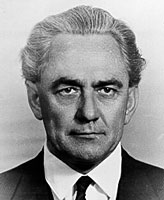Samuel Warren Carey
| Samuel Warren Carey | |
|---|---|
 |
|
| Born |
1 November 1911 Campbelltown, New South Wales |
| Died | 20 March 2002 (aged 90) Hobart, Tasmania |
| Nationality | Australian |
| Institutions | University of Tasmania (1946–1976) |
| Alma mater | University of Sydney |
| Notable awards | Clarke Medal (1969) |
Samuel Warren Carey AO (1 November 1911, in Campbelltown – 20 March 2002, in Hobart) was an Australian geologist who was an early advocate of the theory of continental drift. His work on plate tectonics reconstructions led him to develop the Expanding Earth hypothesis.
Samuel Warren Carey was born in New South Wales and grew up on a farm three miles from Campbelltown. The family was to move to the town centre, saving the young Carey the walk to school. An interest in physics and chemistry during high school was to lead to selection of both subjects when he attended the University of Sydney in 1929. Mathematics was required and he was encouraged to study Geology as his fourth subject, a department still under the influence of retired Professor Edgeworth David. He started a student Geology club as he became attracted to the subject's mixture of laboratory and field work; David gave the inaugural speech. Along with classmates Alan Voisey and Dorothy York, he was to earn high distinctions at the University. He also joined the Sydney University Regiment. His Masters and Honours degree were based on four papers on the Werris Creek area. He received his MSc in 1934. It was at this time that Carey read the 1924 translation of Wegener's The Origin of Continents and Oceans, the book largely responsible for introducing the concept of continental drift to English-speaking academics. He was to become a key figure in advancing this concept and plate tectonic models that followed.
Carey was prevented from taking a research scholarship to Cambridge in 1933. Instead, aged 23, he joined Oil Search in the Sepik District of Papua New Guinea where he worked with a team led by G.A.V. Stanley, mapping the surface geology for indications of subsurface oil. The Sepik is where the Australian Tectonic Plate collides with the Pacific Plate and confirmed for Carey, many of his ideas about what is now known as plate tectonics. The work involved long periods in jungle covered hill country, field working from temporary camps, managing carrier lines and dealing with villagers. All supplies were carried in from the bases at Matapau and Aitape on the coast. The mapping involved surveyors drawing base maps at scales of six inches to the mile, using what was then the most up to date geographical techniques (radio time signals and sextants to observe stars) and geologists, including Carey, plotting the geology onto the maps from exposures in the banks of streams. Carey was in the field when a magnitude 6.3 earthquake with an epicentre near Aitape occurred which devastated the inland villages and the tracks over the coastal mountains. He published a paper reporting on the event in Australian Geographer. After four years in Papua New Guinea, Carey returned to Sydney and wrote and submitted a thesis for a Doctor of Science degree, entitled Tectonic Evolution of New Guinea and Melanesia. The degree was awarded in 1939. He returned to Papua New Guinea and worked there on oil exploration until the outbreak of the Pacific War in 1942. In 1940 he married Austral Robson, with whom he had four children.
...
Wikipedia
